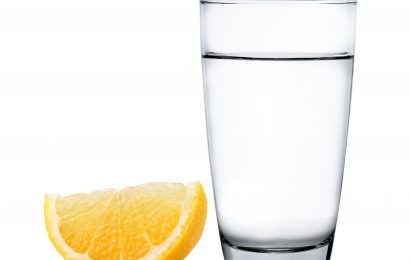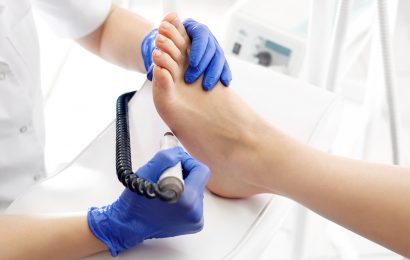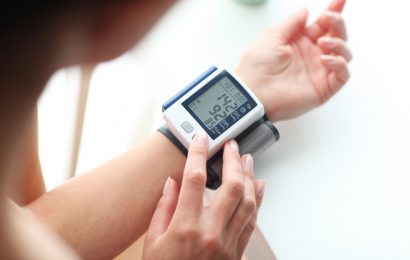It’s well known that people with diabetes are more susceptible to developing certain foot problems, including nerve damage in the feet and reduced blood circulation to the feet, than people who don’t have diabetes. Numbness caused by nerve damage can make foot injuries more likely to happen, since heat, cold, or pressure on the feet may not be noticed. Nerve damage, reduced blood circulation, and high blood glucose can make wounds slower to heal, and they also make them more likely to become infected. An infection that is not treated right away can cause very serious problems. This is why taking care of your feet is very much a part of managing your diabetes.
The basics of taking care of your feet haven’t changed: They include managing your blood glucose, blood pressure, and cholesterol levels; looking at your feet every day (or having someone else look at them for you if you can’t see or reach them easily) so that you will recognize any changes; and seeking help from a medical professional early if you see wounds or other changes in your feet.
While the basics haven’t changed, there are some new tools to help you carry out your daily inspections and to keep the skin on your feet healthy and moisturized. There are also a number of new tools for your foot-care professional to help treat any wounds that develop in spite of your best self-care. This article describes a sampling of those tools.
Prevention aids
Checking your feet every day for swelling, redness, blisters, or cuts is invaluable. But sometimes the first signs of foot problems are not visible. Sometimes an area below the surface of the skin of the foot begins to heat up, or become inflamed, before any visible sign appears. This can happen if your shoe – or an object in your shoe such as a pebble – puts abnormal pressure on a part of your foot, causing inflammation deep inside. If you can’t see or feel this early inflammation – which is often the case – you continue to walk on it, often making it worse.
But now there are products that can help you detect a foot problem before it is visible by detecting temperature changes in the feet. One of these products is TempStat.
TempStat uses specialized liquid crystal technology to monitor the temperature on the bottoms of your feet. The device looks like a home scale with a green area on either side where you place your feet and a magnified mirror in the middle, which you can use to look at the bottoms of your feet. To use the TempStat you sit on a chair or other surface, place your bare feet on the green areas of the device, and wait 60 seconds. During that time, you look at the tops of your feet for any changes. You then pick up your feet and look at the prints on the green areas to see whether there are any visible differences between them. Differences can indicate points of high pressure and inflammation, both of which are predictive of where a wound may develop in the future.
If you see any differences in your footprints, stay off your feet for an hour, then check again. If there is still a difference, call your health-care provider immediately.
TempStat is approved by the FDA to identify areas of inflammation. It sells for about $100 and is only available by prescription. At this time it is not covered by health insurance.
Dry skin
It is not unusual for people with diabetes to have dry skin. Left untreated, dry skin is not only uncomfortable, but it can also lead to cracks in the skin that allow in infection-causing bacteria. Once infected, small cracks can develop into slow-healing wounds. You can prevent and treat dry skin by using moisturizing lotions or creams.
Moisturizers that contain lactic acid may be particularly helpful for dry feet because lactic acid helps the skin retain moisture. One brand-name product that contains a high percentage of lactic acid is AmLactin Foot Cream Therapy. For best results, use AmLactin Foot Cream Therapy twice a day on clean, dry feet. Do not apply AmLactin Foot Cream Therapy – or any other moisturizer – between your toes.
Wound care
If you do develop a wound on your foot, it’s important that it be kept clean and moist to heal. Years ago, it was thought that sores healed best if they were left open to the air to dry out and form a scab. That is not the thinking today. Now experts recommend moist wound healing, which prevents the formation of a scab, to allow a wound to heal from the inside out.
When you apply first aid to a small wound yourself, keep it clean and moist by first washing the area with soap and water, then covering the wound with a bandage. Younger people with healthy skin can often use a regular adhesive strip (such as a Band-Aid) to cover minor wounds. However, older people and those with fragile skin should not apply adhesive directly to the skin. Instead, cover the wound with a sterile, nonstick, gauze pad, use rolled gauze to keep the pad in place, and use tape to affix the end of the rolled gauze to itself, not to your skin.
Larger wounds or any wound that does not start to heal within a day or two should be seen by a health-care professional, possibly one who specializes in wound care. If your wound has already formed a scab when you seek help, your wound-care provider may suggest debriding the wound. Debridement is a technique for removing scabs and dead tissue, resulting in a clean wound.
Never try to debride or remove dead tissue yourself from any wound, especially on your feet. Only a health-care provider who is trained in wound care should perform any form of debridement.
There are four methods of debridement, as follows:
Autolytic. This method employs the body’s own enzymes to liquefy the hardened dead tissue in the wound. Various wound dressings may be used for autolytic debridement.
Mechanical. By moistening a dry dressing such as gauze, applying it to the wound, allowing it to dry, then removing the dry dressing, you also remove some of the dead tissue on the wound. However, this method also removes some healthy tissue and can be painful.
Enzymatic. This method uses a chemical enzyme to speed debridement of dead tissue.
Surgical. The fastest way to remove dead tissue from a wound is for a doctor or other qualified health-care professional to use a scalpel, scissors, or other sharp instrument to cut it away. Most deep wounds need to be surgically debrided, and they may need to be surgically debrided more than once.
There is some disagreement in the medical community about whether all heel wounds should be debrided. If you have a heel wound, therefore, your doctor’s thinking on this matter will influence the treatment he recommends.
When a doctor is surgically debriding a wound, it is not always possible to see the extent of the dead tissue needing removal. There are now devices to help doctors see exactly where to go during the surgery by revealing which tissue still has blood flow (live tissue) and which does not (dead tissue).
According to Dr. Lee C. Rogers, DPM, Associate Medical Director of the Amputation Prevention Center at Valley Presbyterian Hospital in Los Angeles and Chair of the American Diabetes Association’s Professional Foot Care Council, “The SPY Imager from Novadeq is brand-new in the wound-healing arena. It is a novel device that uses a kidney-safe dye that can shows you the blood flow in the skin when looked at with a laser camera. Additional devices that can help doctors assess the blood flow to your limbs are PADnet from BioMedix, and SensiLase from Väsamed.”
Help for healing
In addition to having special techniques for cleaning wounds, doctors have some new tools to help speed the healing of wounds.
TCC-EZ. When you have a wound on your foot, another important aspect of healing is keeping pressure off the wound. This means you should not be putting the weight of your body on the foot that has a wound. In other words, this means no walking until your wound is healed. Since this can take months or even longer, it’s a pretty impossible feat for anyone.
To allow you to walk with less pressure on the bottom of your foot while your wound is healing, your doctor may apply what is called a total contact cast (TCC) that redistributes your weight away from your wound. This is called offloading, and it is considered the gold standard of care as part of the treatment of foot wounds.
The TCC-EZ is a new type of total contact cast that has benefits for both you and your physician. For your doctor, it is much faster and easier to apply than a traditional TCC. After preparing your leg, your doctor simply rolls the single layer “cast sock” onto your foot and leg. Dr. Rogers calls it the “cast sock” because, he says, “It’s almost as easy as putting on a sock. There is a boot attachment that assists the patient in walking.”
The benefit for you is that it protects your wound and allows it to heal in an average of six weeks. The TCC-EZ is lighter, easier on your skin, and not as uncomfortable as a traditional cast. When applied with the outer boot, you can walk and stay active while your wound is healing. However, the cast should not be allowed to get wet.
Negative pressure wound therapy. Commonly known as Wound V.A.C., which stands for vacuum assisted closure, this tool promotes wound healing by applying suction (negative pressure) to a wound. This negative pressure changes an open wound to a “closed wound” as it removes fluid from the wound. This concept has been shown to help wounds heal by improving circulation and removing waste fluids from the wound.
Negative pressure wound therapy consists of three components that work together: a nonstick dressing, a vacuum-assisted canister and hose that provide negative pressure (like a vacuum cleaner), and a clear film dressing to seal the wound, the dressing, and a drainage tube. The frequency of dressing changes depends on the size and type of the wound, but it is usually done every 48 hours.
In the opinion of Dr. Rogers, “This is certainly the biggest advancement in wound healing.”
Dermagraft. Dermagraft is considered a skin substitute and is used to treat diabetic foot ulcers. It is made from human cells, specifically the cultured cells of baby foreskins. (Dr. Rogers says one foreskin can grow about six tennis court sizes of skin!) These cells have been placed on a dissolvable mesh material that is placed on a clean wound bed (one that has been debrided). The mesh is gradually absorbed, and the human cells grow into place, replacing the damaged skin. The living cells in the graft produce many of the same proteins and growth factors found in healthy skin, which help to rebuild the damaged tissue in an ulcer.
Dermagraft is intended to help close ulcers that have been present for more than six weeks. It should not be used on infected ulcers or those that involve tendons, muscles, joints, or bone.
Dr. Rogers said, “It has been shown in clinical trials to heal wounds much faster.”
To raise the likelihood of treatment success, the manufacturer of Dermagraft, Advanced BioHealing, supports a program called Heal2gether that pairs up people being treated with Dermagraft with a “treatment partner,” who phones weekly to remind the person about doctor appointments and also checks in to discuss the therapy and offer information and support. Advanced BioHealing also provides education and information about diabetic foot ulcers at community events such as health fairs. You can learn more about the program at www.heal2gether.org.
DermaClose. The DermaClose RC Continuous External Tissue Expander is a first-of-its-kind product that helps close wounds by expanding the skin around a wound until it is stretched enough for a doctor to stitch the wound closed or to make a smaller wound.
To stretch the skin, a surgeon staples skin anchors (clips with barbs that penetrate the skin) near the edge of the wound. A nylon line is attached to each skin anchor, and the line is gently tightened via the DermaClose RC tension controller. This gradually pulls the skin anchors and edges of the wound together. Dr. Rogers says DermaClose RC Continuous External Tissue Expander can close a wound in three to five days depending on its location.
Tracking the healing process
To see if your wound is healing, your doctor may make use of a type of technology that was used in the making of the Lord of the Rings movie trilogy. Called the ARANZ Medical Silhouette Mobile Camera, it uses lasers to create a 3-D model of the wound.
One of the main benefits of the technology is its ability to accurately measure the surface area of a wound. The alternative method – using a ruler to measure the length and width of a wound – tends to overestimate the size of a wound by about 40%. More accurate measurements allows the doctor to better assess whether the current treatment is working.
(For more information about the products mentioned in this article, click here.)
A team project
Like all aspects of diabetes care, foot care involves a team that includes you. Your role starts with taking good care of your feet – inspecting them daily, wearing shoes and socks that fit, and using a moisturizer if you have dry feet – and bringing any foot problems to your health-care provider’s attention immediately. Even with all of the tools and techniques available today for healing foot wounds, early intervention is still your best bet for complete recovery.
If you develop a wound on your foot, your role in caring for it is no less important. You may have to keep all weight off your foot for an extended period, and you will likely have frequent medical appointments until it heals. There’s no doubt that having a foot wound is a major disruption to your life and lifestyle, but the payoff of sticking with your treatment program and following your wound-care provider’s advice can be huge.




